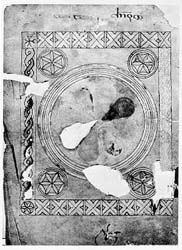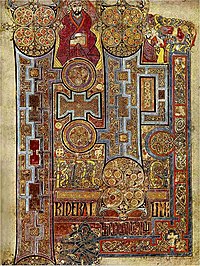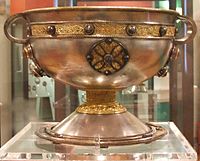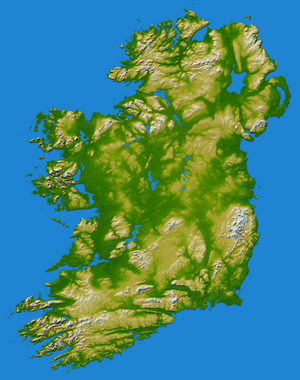User:Angusmclellan/Early Christian Ireland
| History of Ireland |
|---|
 |
|
|
Early Christian Ireland, conventionally dated from the fourth century AD until the beginning of the Viking Age in the ninth century, saw the rise of Christianity and the creation of a literate society.
In the largely prehistoric early period missionaries such as Palladius and Patrick established the Church in Ireland, and legendary kings such as Niall of the Nine Hostages and the Three Collas were credited with creating the political landscape. In later centuries, Irish churchmen, beginning with Columbanus and Columba, were active in Gaul, in Scotland and in Anglo-Saxon England. The mixing of Irish, Pictish and Anglo-Saxon styles created the Insular style of art, represented by the Lindisfarne Gospels and the Book of Kells. Ireland's reputation for scholarship was such that many people travelled from Britain and from European mainland to study in Irish schools.
When compared to neighbouring Insular societies, Early Christian Ireland is extremely well documented, but these sources have not always been easy to interpret. Many questions remain unanswered and the study of Early Christian Ireland continues to produce new theories and new discoveries. From the late nineteenth century, when scholars such as Kuno Meyer and Whitley Stokes applied an increasingly rigorous approach to the study of written sources, a great deal of new information has been extracted from the written material. New fields, such as paleobotany, have contributed to the debate, while the volume of archaeological evidence has increased.
Setting the scene[edit]
Tribes of Ireland according to
Ptolemy's Geographia.[1]
Ptolemy's Geographia, written in the second century AD, gives a partial list of the tribes in Ireland some time earlier. Of the tribes listed, only two appear to have left traces in the Early Christian period, the Voluntii, who are presumed to be the Ulaid of Ulster, and the the Auteini, who may be the Úaithni of southern Connacht. The Iverni are thought to have been the source of the name Érainn. Other than these, Ptolemy's tribes have disappeared by the fifth century AD.[2] As well as these large changes to the political landscape of Ireland, the late Iron Age saw sizable changes in human activity. Following an apparent decline in population in the period from the second or first century BC onwards, confirmed the paleobotanical evidence of pollen samples, the third and fourth centuries saw a rapid recovery.[3]
The reasons for the decline and recovery are uncertain, but it has been suggested that recovery may be linked to the apparent "Golden Age" of Roman Britain in the third and fourth centuries. The archaeological evidence for trade with, or raids on, Roman Britain is strongest in northern Leinster, centred on modern County Dublin, followed by the coast of County Antrim, with lesser concentrations in the the Rosses on the north coast of County Donegal and around Carlingford Lough.[4] Inhumation burials may also have spread from Roman Britain, and had become common in Ireland by the fourth and fifth centuries.[5]
Roman sources mention raids on Britain by Saxons of north-west Germany, by Picts from Scotland and by two groups of people usually associated with Ireland, the Scotti and the Atacotti. The origins and meanings of Scotti and Atacotti is uncertain. Atacotti disappears with the Romans. Scotti means Gaels to Adomnán in the late seventh century, but not to Columbanus in the early sixth century, who uses the older term Iberi instead. The Scotti are perhaps a confederation of tribes in Ulster, and the Atacotti one in Leinster, but this is not certain.[6]
Lorem ipsum dolor sit amet, consectetur adipiscing elit, sed do eiusmod tempor incididunt ut labore et dolore magna aliqua. Ut enim ad minim veniam, quis nostrud exercitation ullamco laboris nisi ut aliquip ex ea commodo consequat. Duis aute irure dolor in reprehenderit in voluptate velit esse cillum dolore eu fugiat nulla pariatur. Excepteur sint occaecat cupidatat non proident, sunt in culpa qui officia deserunt mollit anim id est laborum.
Lorem ipsum dolor sit amet, consectetur adipiscing elit, sed do eiusmod tempor incididunt ut labore et dolore magna aliqua. Ut enim ad minim veniam, quis nostrud exercitation ullamco laboris nisi ut aliquip ex ea commodo consequat. Duis aute irure dolor in reprehenderit in voluptate velit esse cillum dolore eu fugiat nulla pariatur. Excepteur sint occaecat cupidatat non proident, sunt in culpa qui officia deserunt mollit anim id est laborum.
Palladius and Patrick[edit]
Many/most/some/all modern studies of Saint Patrick follow T. F. O'Rahilly's "Two Patricks" theory. That is to say, many of the traditions later attached to Saint Patrick originally concerned Palladius, a deacon from Gaul who came to Ireland, perhaps sent by Pope Celestine I (died 431). Palladius was not the only early Gallic cleric in Ireland. Saints Auxilius, Secundus and Iserninus are associated with early churches in Munster and Leinster. By this reading, Palladius was active in Ireland until the 460s.[7]
Prosper of Aquitaine's contemporary chronicle states:
Palladius was ordained by Pope Celestine and sent to the Irish believers in Christ as their first bishop.[8]
Thus, the appointment of Palladius and his fellow-bishops was not intended as a mission to convert the Irish, but as ministering to existing Christian communities in Ireland. The sites of churches associated with Palladius and other early Gallic saints, are close to royal centres of the period: Secundus is remembered by Dunshaughlin, County Meath, close to the Hill of Tara which is associated with the High King of Ireland; Kilashee, County Kildare close to Naas which is associated with the Kings of Leinster, is probably named for Auxilius. The activity of the Gallic bishops was limited to the southern half of Ireland, the Leth Moga, and there is not evidence for activities in Ulster or Connacht.[9]
Section see also[edit]
Peoples and princes[edit]
Kingdoms of Early Christian Ireland.[10]
The first two centuries of the Early Christian period saw sizable changes in the political map of Ireland. These years saw the rise of the kindreds of the Uí Néill and the Eóganachta, who dominated Ireland for the remainder of the Early Christian period. The evidence of the Irish annals and genealogies for this period is at best unreliable and at worst the victim of later manipulations.
Monasteries and missionaries[edit]
Image from Echternach rather than Durrow/Kells



Lorem ipsum dolor sit amet, consectetur adipiscing elit, sed do eiusmod tempor incididunt ut labore et dolore magna aliqua. Ut enim ad minim veniam, quis nostrud exercitation ullamco laboris nisi ut aliquip ex ea commodo consequat. Duis aute irure dolor in reprehenderit in voluptate velit esse cillum dolore eu fugiat nulla pariatur. Excepteur sint occaecat cupidatat non proident, sunt in culpa qui officia deserunt mollit anim id est laborum.
Lorem ipsum dolor sit amet, consectetur adipiscing elit, sed do eiusmod tempor incididunt ut labore et dolore magna aliqua. Ut enim ad minim veniam, quis nostrud exercitation ullamco laboris nisi ut aliquip ex ea commodo consequat. Duis aute irure dolor in reprehenderit in voluptate velit esse cillum dolore eu fugiat nulla pariatur. Excepteur sint occaecat cupidatat non proident, sunt in culpa qui officia deserunt mollit anim id est laborum.
Lorem ipsum dolor sit amet, consectetur adipiscing elit, sed do eiusmod tempor incididunt ut labore et dolore magna aliqua. Ut enim ad minim veniam, quis nostrud exercitation ullamco laboris nisi ut aliquip ex ea commodo consequat. Duis aute irure dolor in reprehenderit in voluptate velit esse cillum dolore eu fugiat nulla pariatur. Excepteur sint occaecat cupidatat non proident, sunt in culpa qui officia deserunt mollit anim id est laborum.
Vikings and violence[edit]

Lorem ipsum dolor sit amet, consectetur adipiscing elit, sed do eiusmod tempor incididunt ut labore et dolore magna aliqua. Ut enim ad minim veniam, quis nostrud exercitation ullamco laboris nisi ut aliquip ex ea commodo consequat. Duis aute irure dolor in reprehenderit in voluptate velit esse cillum dolore eu fugiat nulla pariatur. Excepteur sint occaecat cupidatat non proident, sunt in culpa qui officia deserunt mollit anim id est laborum.
Lorem ipsum dolor sit amet, consectetur adipiscing elit, sed do eiusmod tempor incididunt ut labore et dolore magna aliqua. Ut enim ad minim veniam, quis nostrud exercitation ullamco laboris nisi ut aliquip ex ea commodo consequat. Duis aute irure dolor in reprehenderit in voluptate velit esse cillum dolore eu fugiat nulla pariatur. Excepteur sint occaecat cupidatat non proident, sunt in culpa qui officia deserunt mollit anim id est laborum.
Lorem ipsum dolor sit amet, consectetur adipiscing elit, sed do eiusmod tempor incididunt ut labore et dolore magna aliqua. Ut enim ad minim veniam, quis nostrud exercitation ullamco laboris nisi ut aliquip ex ea commodo consequat. Duis aute irure dolor in reprehenderit in voluptate velit esse cillum dolore eu fugiat nulla pariatur. Excepteur sint occaecat cupidatat non proident, sunt in culpa qui officia deserunt mollit anim id est laborum.
Notes[edit]
- ^ After Duffy, p. 15.
- ^ Charles-Edwards, p. 152; Byrne, p. 8. Older identifications, such as the the Nagnatae with the Fir Ól nÉchmacht of Connacht, or the Brigantes with various tribes in Leinster, appear to have been abandoned.
- ^ Charles-Edwards, p. 148.
- ^ Charles-Thomas, map 8.
- ^ Charles-Thomas, pp. 175–176.
- ^ Charles-Edwards, pp. 158–160. Origins in the Hebrides have also been suggested for the Atacotti. The Late Roman army as recorded by the Notitia Dignitatum included auxilia palatina named for the Atacotti, the normal interpretation of such names being that they were recruited from prisoners of war.
- ^ Byrne, pp. 78–79; De Paor, pp. 6–7 & 88–89; Duffy, pp. 16–17; Fletcher, pp. 80–83; MacQuarrie, p. 34; Ó Cróinín, pp. 22–23; Thomas, pp.300–306; Yorke, p. 112.
- ^ De Paor, p. 79.
- ^ Duffy, pp. 16–17; Thomas, p. 305.
- ^ After Duffy, p. 15, and Ó Cróinín, p. 307.
References[edit]
- Byrne, Francis J., Irish Kings and High-Kings. B.T. Batsford, London, 1973. ISBN 0-7134-5882-8
- Charles-Edwards, T.M., Early Christian Ireland. Cambridge University Press, Cambridge, 2000. ISBN 0-521-39395-0 Parameter error in {{ISBN}}: checksum
- De Paor, Liam, Saint Patrick's World: The Christian Culture of Ireland's Apostolic Age. Four Courts, Dublin, 1993. ISBN 1-85182-144-9
- Duffy, Seán (ed.), Atlas of Irish History. Gill and Macmillan, Dublin, 1997. ISBN 0-7171-3093-2
- Fletcher, Richard, The Conversion of Europe: From Paganism to Christianity 371–1386 AD. Harper Collins, London, 1997. ISBN 0-00-686302-7
- Harbison, Peter, Pre-Christian Ireland: From the First Settlers to the Early Celts. Thames & Hudson, London, 1988, revised 1994. ISBN 0-500-27809-1
- Hughes, Kathleen, Early Christian Ireland: Introduction to the Sources. Hodder & Stoughton, London, 1972. ISBN 0-340-16145-0
- Kelly, Fergus, Early Irish Farming: a study based mainly on the law-texts of the 7th and 8th centuries AD. Dublin Institute for Advanced Studies, Dublin, 2000. ISBN 1-85500-180-2
- Kelly, Fergus, A Guide to Early Irish Law. Dublin Institute for Advanced Studies, Dublin, 1988. ISBN 0-901282-95-2
- McCarthy, Dan, "The Chronology of the Irish Annals" in Proceedings of the Royal Irish Academy, 1998, pp. 203–255 (Etext).
- Ó Corráin, Donnchadh, "Vikings in Ireland and Scotland in the in the ninth century" in Peritia 12 (1998), pp. 296–339. (Etext)
- Ó Cróinín, Dáibhí, Early Medieval Ireland: 400–1200. Longman, London, 1995. ISBN 0-582-01565-0
- Yorke, Barbara, The Conversion of Britain: Religion, Politics and Society in Britain c.600–800. Longman, London, 2006. ISBN 0-582-77292-3


